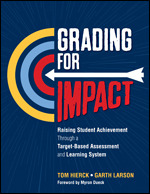Grading for Impact
Raising Student Achievement Through a Target-Based Assessment and Learning System
- Tom Hierck - Educational Consultant
- Garth Larson - President, FIRST Educational Resources
Foreword by Myron Dueck
Aim for a target-based grading system and create stronger learning opportunities!
Do you wish there was more clarity when it comes to measuring student progress and learning? What if there was a way to utilize grading and assessment to focus on learning rather than performance, and the process rather than the product?
As grading, assessment, and reporting continue to be relevant topics of discussion, this book helps you create a functional plan to elevate and advance standards-based grading practices. Teachers and administrators will learn how to assess, grade, and report against specific learning targets rather than standards as a whole to make skill acquisition the highest priority. Grounded in application to provide focus and clarity, this book features:
- Real case studies of schools that have incorporated target-based assessment, feedback, grading, and reporting
- Practical examples to guide implementation
- Questions, checklists, illustrations, and audits of practice to showcase the work in action
- An accessible format and layout that support both immediate implementation and long-term goals
Despite being a topic that generates emotion and resistance to change, target-based assessment builds the foundation for a learner-centered system that provides clear expectations and feedback for teachers, students, and parents.
"Grading for Impact is a simple and straightforward guide to re-thinking grading based on mastery of specific skills and concepts rather than broadly-written standards. Real-world examples of teachers struggling with--and answering--the old questions are included: “How do we grade fairly and accurately?” and “How do we use grades as an instructional strategy?””Joseph Staub, High School Teacher
Downtown Magnets High School, CA
"Most stakeholders agree that report cards aren’t enough to show what our students are learning in school, but changing the traditional grading system is a task that requires careful planning and challenging discussions. Grading for Impact shows educators how to start and plan the discussions that will result in genuine learning experiences for students."
Ernie Rambo, Virtual Learning Community Coordinator
Nevada National Board Professional Learning Institute
Free resources
Webinar: Grading for Impact
Learn from Tom Hierck and Garth Larson, authors of Grading for Impact, how to use target-based assessment, grading, and reporting to provide students with game-changing feedback.
"Student learning and classroom environments are changing, so why not standards-based grading? This book encourages change to target-based grading and asks the 'why not?'"
"Grading for Impact is a simple and straightforward guide to re-thinking grading based on mastery of specific skills and concepts rather than broadly-written standards. Real-world examples of teachers struggling with--and answering--the old questions are included: “How do we grade fairly and accurately?” and “How do we use grades as an instructional strategy?”"
"Many stakeholders agree that report cards aren’t enough to show what our students are learning in school, but changing the traditional grading system is a task that requires careful planning and challenging discussions. Grading for Impact shows educators how to start and plan the discussions that will result in genuine learning experiences for students."
“The unique contribution of Tom Hierck and Garth Larson’s Grading for Impact to the existing compendium of published books on standards-based grading is its tighter focus on what the authors refer to as ‘target-based’ assessment and grading vs. standards-based grading. Learning targets, smaller ‘chunks’ of a larger standard, provide teachers and students with sharper clarity. When learning targets are explicit, teachers are able to keep instruction and assessment tightly focused on those targets and adjust their ongoing instruction—based on assessment evidence—as needed, and students are able to adjust their learning strategies based on the assessment-elicited feedback they receive. This makes grading and reporting much more meaningful, because an individual student’s performance is directly related to specific learning expectations so that both teacher and student can determine ‘next steps’ in the learning journey. Hierck and Larson carefully present the rationale for target-based assessment and grading and then lay out a ‘how-to roadmap’ that any school system can successfully follow to implement these powerful ideas.”
"The 'make or break it' for a practitioner book, however, is 'can the reader now proceed with confidence in implementing the concept or process in his/her school, district, or system.' Seriously, no book I have ever read has been this clear. But, of even more ultimate significance is admonishing the reader not to take the “short cut” of 'borrowing' the examples, forms, etc provided in the book. You effectively interspersed 'gentle warnings' at key points. AND, you made clear the reasons for doing the work locally – the ever-important “buy in” and honoring 'context.'"
